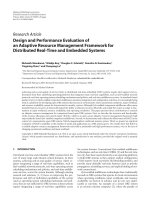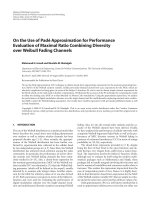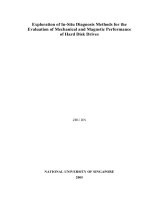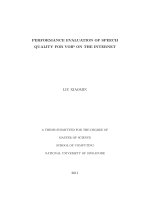Performance evaluation of reaper--cum--binder for harvesting of soybean and rice
Bạn đang xem bản rút gọn của tài liệu. Xem và tải ngay bản đầy đủ của tài liệu tại đây (325.54 KB, 9 trang )
Int.J.Curr.Microbiol.App.Sci (2018) 7(3): 1754-1762
International Journal of Current Microbiology and Applied Sciences
ISSN: 2319-7706 Volume 7 Number 03 (2018)
Journal homepage:
Original Research Article
/>
Performance Evaluation of Reaper--cum--Binder for Harvesting of
Soybean and Rice
Ashutosh Tripathi, B.P. Mishra, Mithlesh Kumar*, Yogesh Singh Thakur and
Kipoo Kiran Singh Mahilang
Department of Farm Machinery and Power Engineering SVCAET & RS, FAE, Indira Gandhi
Krishi Vishwavidyalaya, Krishak Nagar, Raipur, 492012, Chhattisgarh, India
*Corresponding author
ABSTRACT
Keywords
Reaper, Binder,
Rice, Soybean,
Harvesting loss
Article Info
Accepted:
16 February 2018
Available Online:
10 March 2018
The mechanization of harvesting operation is essential to minimize the cost of harvesting,
grain production cost, grain loss, turnaround time, weather risk, and to increase benefit by
appropriate technology. In order to achieve the above goal, a manually controlled reaper cum- binder machine was tested and evaluate. This self-propelled reaper was operated in
low 1st gear at forward speed of 2.5 km/h. It has 1400 mm size of cutter bar and dropped
bundling mechanism. The testing of the machine was carried out with rice and soybean
crop during Kharif season of 2012 at the research farm of Indira Gandhi Krishi
Vishwavidyalaya, Raipur. This machine made crop bundles of rice weighing about 5.3.
The fuel consumption of machine was varied with crop type. It was found 1.22 and 1.15
lit/h with soybean and rice crop respectively. According the cost of operation of reaper cum- binder machine also varied according to type of crop. It was found to be 860 and
1289 Rs/ha with rice and soybean respectively. By using the reaper--cum--binder for rice
crop net saving of 2223 Rs/ha and 2464 Rs/ha can be saved over Naveen and local sickle
respectively. The performance of the reaper -cum- binder was also assessed and compared
with manual harvesting. The reaper -cum- binder machine performed well with rice crop,
whereas in soybean the bundling was not satisfactory which results higher grain loss
(21%). The actual field capacity of the reaper -cum- binder was compared with the
harvesting by local sickle and Naveen sickle on rice and soybean crops. The result
revealed that about 44 times higher field capacity was observed with the machine (0.280.32 ha/h) than that of traditional manual method, over local sickle (0.00657 ha/man-h)
and serrated Naveen sickle (0.00709 ha/ man-h).
Introduction
Harvesting of crops is one of the important
agricultural operation which demands
considerable amount of labour. The scarcity
and high cost of labour during harvesting
season are the serious problem. The total
labour requirement for harvesting of cereals or
pulses vary from 120-200 man-h/ha. Rice is
one of major crops in India as well as in
Chhattisgarh State. The total labour
requirement for growing rice crop is estimated
about 800 man-h/ha, excluding irrigation,
bund making, transport and application of
chemicals
and
fertilizers.
Harvesting,
threshing and transplanting consume about 70
1754
Int.J.Curr.Microbiol.App.Sci (2018) 7(3): 1754-1762
percent of the total labour requirement.
Harvesting operation alone consumes 20
percent which include harvesting by sickles
and bundle making (Dutt and Prasad, 2002).
Traditionally, harvesting of crop is done
manually using sickles, which involves 18-20
man-days per hectare. The cutting and laying
in the windrow consume 65-75 percent of
labour and gathering, making bundles, their
transport and stacking in the field involve the
rest of labour requirement. Rahman et al.,
(1980) reported that the performance of handoperated grain harvester is equivalent to 5-7
times that of man and design features of this
machine revel bright possibilities with some
minor modification, they also stated that
machine represent a base for future research
work.
Various kinds of grain /crop losses occur
during harvesting and thereafter the field
losses, including pre-harvest loss, harvesting
loss, stacking losses, field storage loss and
losses during on-farm transport, threshing and
transport to market. These losses vary from 813 percent for most of the cereals, pulses and
other crops. Sheruddin-Bukhari et al., (1991)
studied the grain loss in wheat harvested by a
front-mounted
reaper-windrower
and
evaluated during field investigation at 2 sites
during 1986.
The performance of the reaper-windrower was
compared with that of conventional manual
harvesting. At the 1st site, the total grain losses
by mechanized harvesting average 41.1 kg/ha
compared to 84.9 kg/ha from manual
harvesting. Labour requirement for machine
and manual harvesting and bundling were 31.1
and 85.8 man-h/ha respectively. At the 2nd
site, grain losses from machine reaping
average 48.0 kg/ha compared to an average of
139.6 kg/ha manual harvesting. Labour
requirements for machine and manual
harvesting were 28.5 and 88.6 man-h/ha
respectively.
Mechanical harvesting of all most all cereal
crops is a challenging problem in India and
tropical countries. Despite the encouraging
fact that India has good potential for
increasing production, method of harvesting
are still primitive and farmer use hand sickle
for this purpose. Garg and Sharma (1991)
developed a reaper-windrower with vertical
conveyor belts for harvesting wheat and rice.
The unit was mounted on the front of tractor,
capable of harvesting 0.4 ha/h, and unlike
combine a harvested does not destroy the
straw, which is important cattle feed. Thus
they reported that compared to conventional
manual harvesting with sickle the new unit
reduce labour requirement by two-third. Rice
harvesting by hand can required about 25% of
total labour requirement of the crop. Ojha and
Nath (1980) stated that the introduction of
efficient harvesting aids and the equipment for
the cereals crops seems to be highly necessary
to minimize the time of harvesting and the
grain loss suffered due to slow rate of work in
process of manual harvesting. Mollah and
Watt (1980) designed and developed a
prototype grain crop harvesting machine. The
machine cut the crops, which were planted in
rows as it was pushed forwarded the cutting
mechanism of the hand powered machine
consisted of two counter rotating cutting discs.
The width of the machine was determined by
the row spacing of the crop as it cuts a single
row. Rashid et al., (1980) developed a push
type harvesting machine, which was operated
by human power from traction wheel. The
power was transmitted to the cam wheel and
then transmitted to the knife with the help of
the knife actuating lever arm. Yadav and
Yadav (1992) have worked on designed and
development of simple, rugged oxen-drawn
reaper for harvesting cereals, pulse crops and
oil seed in India. An animal - drawn reaper
with an engine operated cutting and conveying
mechanism was designed and constructed by
Singh and Singh (1995) for harvesting wheat
1755
Int.J.Curr.Microbiol.App.Sci (2018) 7(3): 1754-1762
and rice. Howson and Devnani (1981) studied
and compared the economic feasibility of the
harvester for different widths of cut and field
grain yields with manual harvesting. Provided
the cutting width is great enough its use is
economic. The smallest practical width of cut
is 1 m for a power operated machine.
Manjunatha et al., (2009) have done a study
on reducing the cost of cultivation in rice
through mechanizing harvesting operations at
agricultural research station, Gangavathi
during Kharif, 2002 to Rabi /summer, 2004-05
and also in the farmer's field. A vertical
conveyor power reaper (Kamco modelkr 120)
was used for the purpose. The overall
performance of the vertical conveyor reaper
was quite satisfactory. The actual field
capacity of the power reaper was 0.3 ha/hr
with a field efficiency of 73 % at an average
operating speed of 3.2 kmph. The fuel
consumption was 5.5 l/ha. The cost of
cultivation of rice crop could be reduced
through
mechanization
of
harvesting
operations. Cost of mechanical harvesting was
Rs.420/ha as compared Rs. 800/ha in the case
of manual harvesting provided the machines
are used for their maximum usage of 144
hectares in a year. Guruswamy et al., (1996)
modified and evaluated a self-propelled
vertical reaper -cum- windrower for
harvesting safflower during 1993-94 at the
Regional Research station Farm, Raichur,
India, and computed with manual harvesting.
Harvesting time per hectare was computed to
be 10 h for the machine, compared with 150
ma-hours for manual harvesting. The postharvest, cutting and conveying losses for the
machine were 0.05 %, 0.47 % and 0.23 (total
loss of 0.75 %), respectively and for manual
harvesting these values were 0.05 %, 0.02 %
and 0.00 % (total loss of 0.07 %), respectively.
Prabhakar et al., (2000) reported that a selfpropelled reaper was earlier introduced in
South India for harvesting rice by CIAE-IRRI
Industrial Extension Project. The Reaper was
modified by reducing the height of the cutter
bar knife and speed of cross conveyer belt and
evaluated for harvesting soybean in Madhya
Pradesh. The main objective of this paper is to
study the field performance of reaper -cumbinder for harvesting of soybean and rice.
Materials and Methods
Study area
The testing was carried out during Kharif and
Rabi seasons of 2012-2013 at the research
farm
of
Indira
Gandhi
Krishi
Vishwavidyalaya, Raipur (C.G). The IGKV
farm is situated on national highway no. 6 in
eastern part of Raipur city and located
between 20o40’N latitude and 81o39’E
longitude with an altitude of 293 m above
mean sea level. The climate of this region is
dry moist, sub humid and region receives
about 1200-1400 mm rainfall annually, out of
which about 88 percent is received during
rainy season (June to September) and 8
percent during winter season (October to
February). May is the hottest and December is
coolest month of the year. The temperature
during the summer months reaches as high as
480C and drop to 60C during December to
January.
Working principle of reaper--cum--binder
The manufacturer and supplier had not
supplied manual and details with the machine
therefore suitability of the crop is not known
however looking its design it seems that it can
be used to harvest the crop of height about 80
to 110 cm. It has reciprocating cutter bar of
cutting width about 140 cm which get rotary
motion from the engine. The cut crop material
was tied into bundles by its knotting
mechanism and left on the field. During
harvesting of the crop the cutting unit collects
the harvest crop from on both left and right
side and pushes towards the middle position of
machine for dropping the bundles where the
1756
Int.J.Curr.Microbiol.App.Sci (2018) 7(3): 1754-1762
spring and ratchet mechanism releases the
bundles. For binding a rope from the bundle
chamber comes through a needle and knotting
mechanism makes a knot on the collected
crop.
Preparation of reaper-cum-binder for field
Test
After preliminary checking the field test of
machine were conducted at the IGKV farm
Raipur, Research Farm during Kharif and
Rabi season 2012-2013 with major crop rice,
soybean as shown in Table 1.
Results and Discussion
Field performance of reaper -cum- binder
with rice
The reaper -cum- binder machine was run on
rice (Mahamaya) at maturity stage (116 das)
and moist field condition. The crop field
condition shows in appendix-G. During testing
all the components of the machine worked
satisfactory. The detail result and discussion,
performance parameters wise are given belowWorking speed in rice field
The machine was tested to harvest rice crop
and operated in IGKV farm at controllable
speed ranging from 2.32 to 2.52 km/h, the
harvesting capacity, field efficiency, fuel
consumption and losses were recorded and
shown in Table 2. The minimum field capacity
(0.294 ha/h) were observed at the lowest
forward speed of 2.32 km/h. Similarly at the
maximum forward speed of 2.52 km/h which
was obtained at full throttle of reaper with Igear gave highest field capacity as 0.32 ha/h.
It is evident from the data presented in Table
2. That the variation in the speed of reaper had
positive effect on the field capacity of the
reaper.
Actual field capacity with rice
The performance of the machine on rice was
found satisfactory and the detail as shown in
Table 2. The actual field capacity of the
machine was found to be 0.31 ha/h with SD
0.0097 which was considered normal and
satisfactory. The field and crop condition was
suitable for harvesting. The field capacity was
observed in Ist gear, in the gears (2nd, 3rd, and
4th) the machine was not operated. In Ist-gear
no clogging was observed. However, further
more field capacity (0.32 ha/h) could be
achieved.
The actual field capacity of the reaper-cumbinder to harvest the rice crop was compared
with the harvesting by sickle and Naveen
sickle (serrated), which reveals that the
maximum average actual field capacity (0.32
ha/h) was found with the reaper -cum- binder
followed by the Naveen (0.00709) and local
sickle (0.00657) as shown in Figure 1. The
reason for this attributes the method of
harvesting and speed.
The reciprocating cutter bar cut the crop with
the help of serrated knife and gathering unit
and a unit of oscillated assembly on both left
and right side collect the harvested crop
towards middle position of cutter bar of the
reaper and a rope from the bundle chamber
comes through a needle and knotting
mechanism makes a knot on the collected
bundles. The spring and ratchet mechanism
releases the bundles. Whereas in case of
manual harvesting by sickle, the operator has
to exert force to cut the crop in bending
posture, which decreases the speed of
operation. Hence the speed and also the
coverage area of cutting are higher in case of
reaper -cum- binder. However, for the further
calculation and comparison purpose the
average speed 2.44 km/h with as average field
capacity 0.31 ha/h been taken into
consideration.
1757
Int.J.Curr.Microbiol.App.Sci (2018) 7(3): 1754-1762
Table.1 Field test condition
1.
2.
3.
4.
5.
6.
7.
8.
Location
Kind of field
Type of soil
Condition of crop
Type of Crop
Variety of crop
Avg. Height of plant, cm
Plant/tiller/ear head
population, no/m2
9. Avg. panicle length
10. Condition of operator
11. Body posture
12. Operator
13. Wedge of operator
IGKV farm
Medium Land
Sandy Clay
Physiological Maturity Physiological Maturity
Rice
Soybean
Mahamaya
JS 97-51
85
42
269
34
24.5
3
Normal, male age 23 yr. – 40 yr.
Normal Sitting Position
One Skilled
175/day
Table.2 Field performance of reaper -cum- binder with rice
Observ
ations
1
2
3
4
5
Mean
S.D
Speed of
operation,
km/h
2.43
2.52
2.45
2.49
2.32
2.44
0.076
Actual Field
capacity,
ha/h
0.308
0.320
0.311
0.316
0.294
0.310
0.0097
Field
efficiency,
%
86.44
89.64
87.15
88.57
82.53
86.87
2.72
Fuel
consumption
, l/h
1.12
1.19
1.20
1.13
1.15
1.158
0.096
Harvesting
grain loss,
%
1.028
1.52
1.30
1.33
1.84
1.40
0.299
Labour
required
man-h/ha
3.30
3.13
3.21
3.16
3.40
3.24
0.11
Table.3 Field performance of reaper -cum- binder with soybean
Observations
1
2
3
4
5
Mean
S.D
Speed of
Actual
Field
Fuel
Harvesting Labour
operation,
Field
efficiency, consumption, grain loss, required
km/h
capacity,
%
l/h
%
manha/h
h/ha
3.1
0.37
83.35
1.15
19.65
2.66
3.15
0.38
84.7
1.21
19.82
2.62
2.95
0.35
79.32
1.3
22.09
2.8
2.89
0.34
77.7
1.13
22.98
2.85
3.11
0.37
83.62
1.35
21.93
2.65
3.04
0.36
81.74
1.228
21.29
2.72
0.11
0.013
3.04
0.035
1.48
0.102
1758
Int.J.Curr.Microbiol.App.Sci (2018) 7(3): 1754-1762
Table.4 Economics of self-propelled reaper -cum- binder for rice and soybean
S.
Harvesting
No. Machine/method
1
2
3
Reaper -cumBinder
Naveen Sickle
(serrated)
Local Sickle
Labour
required,
man-hr/ha
Rice Soybean
3.22
2.72
Cost of
operation,
Rs/hr
Rice Soybean
267
267
Harvesting &
binding cost,
Rs/ha
Rice Soybean
860
1289
Additional
expenditure,
Rs/ha
Rice Soybean
-----
141
143
21.87
21.87
3083
3127
2223
1838
152
160
2187
21.87
3324
3499
2464
2210
Fig.1 Average effective field capacity of different harvesting methods of rice
Fig.2 Average energy consumption of different harvesting methods of rice
1759
Int.J.Curr.Microbiol.App.Sci (2018) 7(3): 1754-1762
Fig.3 Average effective field capacity of different harvesting methods of soybean
Fig.4 Economics of self-propelled reaper -cum- binder for rice and soybean
Labour requirement
The labour requirement in term of womenh/ha was calculated for the harvesting of. The
labour requirement for harvesting by local
sickle, Naveen sickle and reaper -cumbinder, were found as 152 man-h/ha, 141
man-h/ha and 3 man-h/ha respectively. This
showed that use of reaper -cum- binder saved
labour to a substantial extent. Dependence on
uncertain labour availability in rural areas in
now days, creates a big problem to the
farmers. Therefore the self-propelled reaper cum- binder would prove boon to the farmer
1760
Int.J.Curr.Microbiol.App.Sci (2018) 7(3): 1754-1762
under such condition. The labour requirement
of reaper -cum- binder for harvesting of rice
is shown in Table 2.
Fuel consumption
Fuel consumption in litre per hour was
measured by the fuel tank top fill method.
Average fuel consumption of reaper -cumbinder during harvesting operation of rice was
recorded as 1.158 lit/h.
Energy consumption
The energy consumption during rice
harvesting operation for reaper -cum- binder
depicted in Figure 2. It reveals that the
maximum energy consumed 267.5 MJ /ha
was recorded in case of self-propelled reaper cum- binder under local stickle followed by
238 MJ/ha and Naveen sickle 221 MJ/ha.
Reaper -cum- binder consumed more energy
than the local and Naveen sickle this is due to
combination of machine fuel and man energy
for operating a reaper.
Field performance of reaper-cum-binder
with soybean
The reaper -cum- binder machine was run on
Soybean (JS 97-52) at maturity stage (123
das) and moist field condition. The
performance of the machine with soybean is
shown in Table 3 and Figure 3. It was found
not satisfactory, because during harvesting the
crop collecting fork on both left and right side
could not collect the harvested crop towards
the middle position of binding unit, this was
happen due to more height of fork from the
ground. Cutter bar also not found suited to the
soybean plant height and thus maximum
number of plant remains un-harvested.
The quality of work was evaluated with the
traditional manual method. In case of selfpropelled reaper -cum- binder the harvesting
loss of soybean were found comparatively
more (about 21%), than the traditional method
of harvesting (< 2%), looking to losses this
can be said to be not suitable for soybean. So
that reaper -cum- binder not worked
satisfactory for harvesting soybean.
Cost economics of the operation of reaper cum- binder
An economical cost of self-propelled reaper cum- binder and traditional methods of
harvesting of crop (with local and Naveen
sickles) are shown in Table 4 and Figure 4.
The machine self-propelled reaper -cumbinder on the basis of the economics approach
to suit the small and medium farmers. The
cost of harvesting of rice was found
maximum with local sickle (3324 Rs/ha),
followed by Naveen sickle (3083 Rs/ha)
whereas the lowest cost was recorded with the
reaper -cum- binder (860 Rs/ha). Therefore
net saving of Rs 2464 /-per hectare is
recorded with the self-propelled reaper -cumbinder over traditional manual harvesting.
The cost of harvesting of soybean was found
maximum with local sickle (3499 Rs/ha),
followed by Naveen sickle (3127 Rs/ha)
whereas the lowest cost was recorded with the
reaper -cum- binder (1289 Rs/ha). Therefore
net saving of Rs 2210 /-per hectare is
recorded with the self-propelled reaper -cumbinder over traditional manual harvesting, but
the cost of harvesting of soybean was found
more than rice.
The reaper performed satisfactory. It was
found suitable for harvesting rice and soybean
crop it gave satisfactory level of field
capacity, harvesting losses and cost of
operation. Thus on the basis of information
secured throughout the study the following
conclusion could be inferred. The actual field
capacity of the reaper-cum-binder to harvest
the rice crop was compared with the
1761
Int.J.Curr.Microbiol.App.Sci (2018) 7(3): 1754-1762
harvesting by sickle and Naveen sickle
(serrated), Which reveals that the maximum
actual field capacity (0.31 ha/h) was found
with the reaper -cum- binder followed by the
Naveen (0.00709) and local sickle (0.00657).
The average field efficiency of the reapercum-binder was found to be 86 per cent and
the labour requirement for harvesting by local
sickle and reaper-cum-binder, was found as
152 man-h/ha, 141 man-h/h and 3 man-h/ha
respectively. Harvesting loss of rice were
found comparatively more (about 1.2%), than
the traditional method of harvesting (<1%)
was found. The performance of the machine
with soybean was found not satisfactory. The
harvesting loss of soybean were found
comparatively more (about 21%), than the
traditional method of harvesting (< 2%).
Reaper-cum-binder consumed more energy
(267 MJ/ha) than the local (238 MJ/ha) and
Naveen (221 MJ/ha) sickle this is due to
combination of machine fuel and man energy
for operating a reaper. Reaper-cum-binder
consumed more energy (267 MJ/ha) than the
local (238 MJ/ha) and Naveen (221 MJ/ha)
sickle this is due to combination of machine
fuel and man energy for operating a reaper.
References
Dutt, P. and Prasad, J. (2002). Modification and
evaluation of self-propelled reaper for
harvesting soybean. AMA. 3:43-46.
Garg, I. K. and Sharma, V. K. (1991). Tractor
operated
vertical
conveyor
reaperwindrower. Indian farming. 40 (11): 32-36.
Guruswamy, T., Desai, S. R., Veeranagouda, M.
and Barker, R. D. (1996). Performance
evaluation of vertical conveyor reaper
windrower. Karnataka J. Agric.Sci. 9(1):
102-105.
Howson, D. F. and Devnani, R. S (1981). A
width-of-cut analysis of a vertical conveyor
cereal reaper for Indian farm. AMA. 23 (3):
9-14.
Manjunatha, M. V., Masthana, B. G., Reddy, S.
D., Joshi, and V. R. (2009). Field
performance evaluation on vertical
conveyor rice reaper, Karnataka J. Agric.
Sci, 22(1): 140-142.
Mollah, M. M. R. and Watt, C. D. (1980). A novel
grain crops harvester for Bangladesh. Land
and water use, Dodd and Grace. 2007-2013.
Ojha, T. P. and Nath S. (1980). Studies on
harvesting of crop minimizing harvest and
post-harvest losses. Bulletin on harvest and
post-harvest technology (ICAR) Scheme.
IIT Kharagpur. 4-9
Prabhakar D. J. and Prasad, J. 2000. Modification
and evaluation of a self-propelled vertical
conveyor reaper for harvesting soybean.
AMA. 31(3): 43-46.
Rahman, S., Sanajpati, J. N. and Mohama, A. R.
(1980). Design and development of hand
operated grain harvester. AMA. 3 (4): 7980.
Rashid, M. A., Rahman, S. and Sanajpati, J. N.
(1980). Design and development of handoperated grain harvester. AMA. 11(1): 7980.
Sheruddina- Bukhari, Mughal, A. Q., Baloch, J.
M. and Malik, R. J. (1991). Grain losses in
wheat harvested by tractor front mounted
reaper-windrower, AMA. 22(3): 15-20.
Singh, T. P. and Singh, B. (1995). Design and
development of an animal drawn, engine
operated reaper. AMA. 26(2): 29-34.
Yadav, R. N. S. and Yadav, B. G. (1992). Design
and development of CIAE bullock drawn
reaper. AMA. 23(2): 43-51.
How to cite this article:
Ashutosh Tripathi, B.P. Mishra, Mithlesh Kumar, Yogesh Singh Thakur and Kipoo Kiran
Singh Mahilang. 2018. Performance Evaluation of Reaper--cum--Binder for Harvesting of
Soybean and Rice. Int.J.Curr.Microbiol.App.Sci. 7(03): 1754-1762.
doi: />
1762









